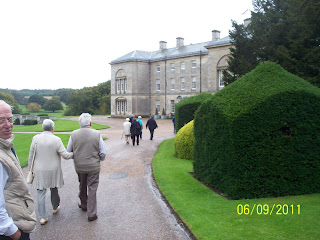Despite the vagaries of last-minute commitments more
than a dozen members of the York branch of the CEGV managed to gather north of
the historic English town of Stamford Bridge on Monday 28 May
2012.
We were visiting two contrasting churches in the Sand
Hutton Group of 10: St Mary’s in Sand Hutton itself and St Botolphs in Bossall.
St. Marys was completed in 1847 and built by the Walker family, replacing the
former church of St Leonards, the ruins of which were immediately adjacent. The
ruins, of St Leonards, are now officially listed, with all the administrative
and financial problems that this entails. After a brief tour of the church and
the ruins, we celebrated Communion with our Branch Chaplain and our Chairman
played the Makin organ installed just 4 years ago.
After lunch at a local pub, we travelled to the tiny
village of Bossall, reputed to be the smallest parish in the York Diocese,
consisting of just seven buildings, including the church! The village had been
decimated by the Black Death and many of the former dwellings were never
re-occupied. This cruciform church was completed in 1147 and is set in a
stunning location with wonderful views of the Wolds from the churchyard, which
is a site of Special Scientific Interest and therefore cannot be cut until
July.
The building itself is in good condition after a special
fund-raising effort to mark its 850th anniversary last century and
there is also an early lych gate by Thomson of Kilburn, manufactured before he
had adopted the mouse as his emblem, stained glass by Kempe and a pipe organ by
Harrison and Harrison (1906).
The weather was hot and sunny after recent rain, which
showed off the countryside to marvellous effect – a good time was had by all.
Our thanks to the Churchwardens of both churches for looking after us so well
and to the Rev Ivan Howitt for facilitating the visits.




